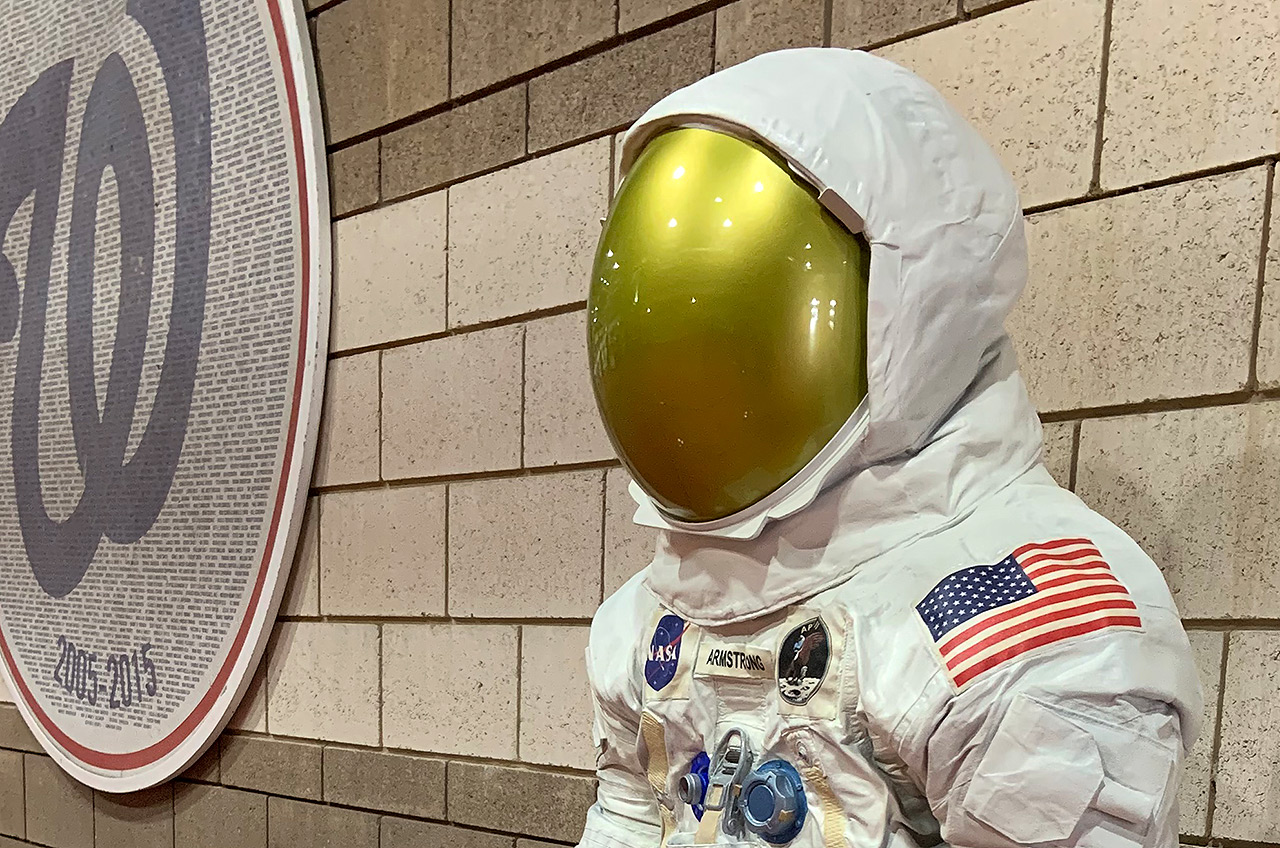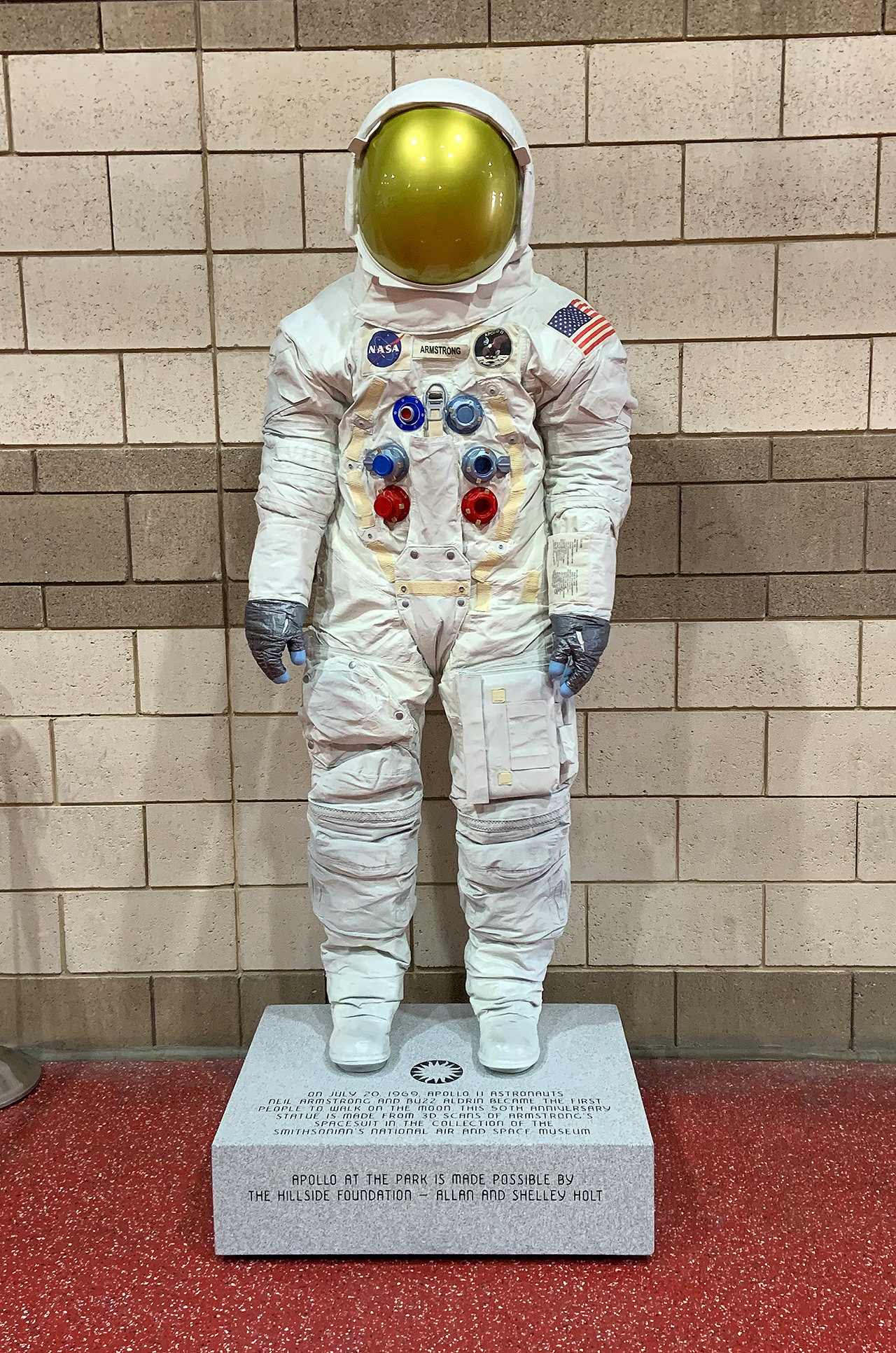Smithsonian Unveils Statue of Neil Armstrong's Spacesuit at Ballpark

Fans heading out to Nationals Park for a baseball game can now make a "short stop" to see a monument to Apollo 11 moon landing history.
The Washington Nationals on Tuesday (June 4) became the first of 15 Major League Baseball (MLB) clubs to display a Smithsonian-created, interactive statue of astronaut Neil Armstrong's Apollo 11 spacesuit. The "Apollo at the Park" program is part of the National Air and Space Museum's celebration of the 50th anniversary of the 1969 mission that made Armstrong the first man on the moon.
"They took the data that we obtained during a 3-D scan of Neil Armstrong's spacesuit and printed a mold to make several copies. They then they applied the photogrammetry and high resolution photography to the cast and painted it accordingly," said Cathleen Lewis, a space history curator at the National Air and Space Museum in Washington, D.C. "It is incredibly realistic. At this resolution, you can see all of the threads running through the surface of the suit."

Related: The Evolution of the Spacesuit in Pictures
The real spacesuit, which has been off display for the past 13 years, will debut to the public at the National Air and Space Museum on July 16.
At Nationals Park, game attendees can find the statue on their way to and from their seats.
"The statue is on our concourse near our home plate gate. What that means is that our fans are going to naturally encounter this statue when they're walking to get their hot dog or a drink," said Gregory McCarthy, the Nationals' senior vice president for community engagement, in an interview with collectSPACE.com. "There are going to be tens of thousands of people walking by the statue at every game."
Get the Space.com Newsletter
Breaking space news, the latest updates on rocket launches, skywatching events and more!
That crowd is what led the Smithsonian to bring Apollo to the park, said Lewis.
"A ballpark seemed to be the perfect venue to share this spacesuit," Lewis told collectSPACE. "We wanted the broadest way we could share it with the nation and the ballparks seemed ideal because people all over the country will have a chance to see the suit who might not otherwise have the chance to see [the real artifact] at the museum."
Further, unlike the museum's encased artifact, the statues are more accessible to the public.
"There are certain areas of the statue that our fans can use their phones to scan and they're going to have videos and other types of material pop-up. So while people are here to enjoy the game, it is also a great educational experience," said McCarthy. "It's a great blend of technology with a 50-year old spacesuit — it's the best of both worlds."
Additional National League teams set to receive statues include the Atlanta Braves (SunTrust Park), Chicago Cubs (Wrigley Field), Cincinnati Reds (Great American Ball Park), Colorado Rockies (Coors Field), Pittsburgh Pirates (PNC Park) and San Francisco Giants (Oracle Park).
Apollo at the Park will also be exhibited at American League ballparks, including the Boston Red Sox (Fenway Park), Cleveland Indians (Progressive Field), Detroit Tigers (Comerica Park), Houston Astros (Minute Maid Park), Minnesota Twins (Target Field), New York Yankees (Yankee Stadium), Seattle Mariners (T-Mobile Park) and Tampa Bay Rays (Tropicana Field).
The spacesuit statues will debut over the next several weeks, with all 15 intended to be on display by the moon landing's 50th anniversary on July 20. At Nationals Park, the statue will be exhibited through the end of the baseball season, with a special celebration planned for July 5, including a limited giveaway of Apollo at the Park t-shirts.
"July 5th is Apollo Night at the park. During the whole game, we'll be celebrating the Apollo missions. We'll have a lot of entertainment and recognition on the field," McCarthy told collectSPACE, adding that the team's bald eagle mascot, Screech, will also suit up in space gear that night.
"For us to be able to merge the educational and cultural mission of the National Air and Space Museum with the national pastime of baseball is, forgive me, a 'home run' for both institutions," said McCarthy. "It is a quintessentially American experience at a quintessentially American place — the ballpark — so this is a win-win for everybody.”
Click through to collectSPACE to see more photos of the Apollo at the Park statues of Neil Armstrong’s spacesuit.
- 'Apollo at the Park' to Bring Armstrong Spacesuit Statues to MLB Baseball
- Reading Apollo 11: The Best New Books About the US Moon Landings
- NASA Astronaut Is Photographing Every Baseball Stadium from Space
Follow collectSPACE.com on Facebook and on Twitter at @collectSPACE. Copyright 2019 collectSPACE.com. All rights reserved.
Join our Space Forums to keep talking space on the latest missions, night sky and more! And if you have a news tip, correction or comment, let us know at: community@space.com.

Robert Pearlman is a space historian, journalist and the founder and editor of collectSPACE.com, a daily news publication and community devoted to space history with a particular focus on how and where space exploration intersects with pop culture. Pearlman is also a contributing writer for Space.com and co-author of "Space Stations: The Art, Science, and Reality of Working in Space” published by Smithsonian Books in 2018.In 2009, he was inducted into the U.S. Space Camp Hall of Fame in Huntsville, Alabama. In 2021, he was honored by the American Astronautical Society with the Ordway Award for Sustained Excellence in Spaceflight History. In 2023, the National Space Club Florida Committee recognized Pearlman with the Kolcum News and Communications Award for excellence in telling the space story along the Space Coast and throughout the world.










